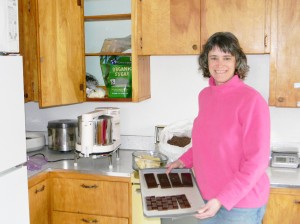
By Michael Howell
Inspired by her own love for chocolate and a predilection for keeping things simple and pure, Jennifer Wicks began experimenting with the art of chocolate making in her home about four years ago. At first it was to please herself, her family and friends. Now, after a few years of refining the process, she is out to please a few “customers” as well.
Years ago she noticed that a lot of chocolate available on the market had a lot of unpronounceable ingredients. Why is that, when real, delicious chocolate is made from the simplest of ingredients?
So back in 2008, Wicks set out to see if she could make her own chocolate from scratch. She found out she could. She also found some value in skipping a step or two, when it comes to making the best use of her time. She has learned to let others do the cracking and winnowing of the cocoa beans. Another step she currently skips is squeezing the cocoa butter from the beans, although she does hope to incorporate that into her work in the future. Sometimes knowing that you could do it if you had to is enough.
She does do her own grinding, however, in a Champion juicer, modified for the purpose. One thing Wicks has found out in her quest to produce homemade chocolate from scratch is that most of the machinery designed specifically for chocolate making is designed for huge production processes and is of a giant scale. As a result, most of the equipment she uses is either modified or invented to do the job on a small scale. The only piece of equipment she currently uses that is specifically designed for chocolate making is the tempering machine.
The tempering process is crucial and involves alternately heating, cooling and reheating the chocolate liquor to specific temperatures to reduce undesired crystalline structures in the mix that can cause the chocolate to be dull, soft, brittle and streaked or grayish in appearance.
The process actually starts with the cocoa beans. The 25-pound bag that Wicks is currently working out of comes from a farm in Ecuador. She has used beans from various places, such as Peru and Venezuela. She said the beans take on a flavor from the place they are grown. Not only that, but different batches of beans from the same place can vary in flavor as well.
Cocoa beans only grow on trees within 15 degrees latitude north and south of the equator. The trees begin to yield fruit within 3 to 5 years after planting. The pods are harvested by hand and cut open revealing the seeds (beans) and pulp. The seeds and pulp are scooped out and placed in piles to ferment for 3 to 9 days, developing the rich flavor and aroma of the beans. They are then dried, typically in the sun, for at least a week, before being bagged and shipped.
As a result, the beans Wicks uses will always come from far away. But she is very interested in that part of the process and hopes, via the Michigan couple who currently supply her with her beans, to visit the growers in Ecuador.
Now, after the picking, roasting, cracking and grinding, the little nibs of cocoa are ready to be liquefied into a thick paste called liquor. Here is where the other ingredients come in, the cocoa butter and the sugar.
The second ingredient, cocoa butter, actually comes from cocoa beans as well. Cocoa beans are 53 percent cocoa butter and 47 percent pure cocoa solids. When compressed, the butter can be separated from the solids, producing pure cocoa butter and unsweetened cocoa powder.
The third ingredient, according to Wicks, needs to be some sort of sugar. Honey won’t work. She has tried, since she raises bees, but it has too much moisture in it. So she uses organic evaporated cane sugar.
Mixed in just the right proportion, the cocoa butter and sugar are added to the liquor and put into the Antha Spectra, a steel drum with granite rollers, for about 40 to 48 hours. This smoothes the sugar grains and allows acids and moisture to evaporate. It is then poured into molds where it will cool and harden. Finally it goes to the plastic wrap machine.
There you have it, the three simple and pure ingredients in every bar of Burnt Fork Bend dark chocolate. The milk chocolate bars, of course, have one further ingredient: powdered milk.
Wicks has experimented a lot over the years, changing the percentages of the ingredients. Her own taste and that of her family and friends have led to a dark chocolate bar that is 72 percent cocoa.
Her kitchen, located along a bend of Burnt Fork Creek, east of Stevensville, just passed government inspection last September and she is slowly gearing up for business.
As you can see from the photographs, her chocolate molds produce a bar with the name of her business, Burnt Fork Bend, rising in relief surmounted by a lone heron standing in a bend of the creek.
Asked how a heron came to be her business’s image, she said it just had to be a heron. She said that growing up in Delaware as a child, one day she heard a tapping on the glass door to the back of the house. Pulling the drapes open she found herself face to face with a large heron tapping on the glass.
“Since then, they’ve always been around,” was all she said.
Her business logo was designed by an artist based on a photograph of a heron standing in the creek outside her kitchen.
Burnt Fork Bend chocolate bars are currently available for sale at the Bitterroot Star in downtown Stevensville and Back to Nature in Missoula. If you want some, you can call Jennifer Wicks at 370-8606 or e-mail burntforkbend@hotmail.com and she will whip you up a batch.